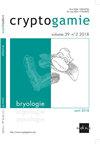两种同域弯曲肢的形态计量学比较。(亮苔藓科,苔藓植物)种
IF 0.9
3区 生物学
Q4 PLANT SCIENCES
引用次数: 0
摘要
弯曲藤。是一个分布广泛的属,有一些非常通才的种。非性别表达植物和非性别表达植物之间的形态差异以及频繁出现的非性别表达芽给该群体的鉴定带来了困难。我们的主要目的是形态学上比较两种Campylopus julaceus A.Jaeger和lamellatus Mont的配子体。对21个配子体性状进行了形态计量学分析,定量分析了它们的性表达,并对黄菖苣无性繁殖体的生存能力进行了测试。我们的结果表明,这些假定的物种不会形成两个相互排斥的群体。黄菖蒲中有性表达量显著(84.4%,雌性占88.2%,雄性占11.8%),而薄叶菖蒲中有性表达量低(5.29%,雌性占55.5%,雄性占44.5%)。两种植物均有无性繁殖体,但尤勒斯(C. julaceus)的无性繁殖体表达频率更高(100%;薄叶蝉31%)。繁殖体再生50% ~ 60%,在2天内形成块根状体或绿色原丝体。板状弯曲菌通常是不育的,而朱拉索菌显然只有有性形式。此外,由于该物种的性成功可能受到性别空间隔离的限制,因此无性繁殖应有助于种群维持。最后,我们强调了在种群水平上进行DNA分析研究的重要性,这些研究涉及全球收集的标本,以更好地理解弯曲虫的同域种划分。本文章由计算机程序翻译,如有差异,请以英文原文为准。
A Morphometric Comparison of Two Sympatric Campylopus Brid. (Leucobryaceae, Bryophyta) Species
ABSTRACT Campylopus Brid. is a widely distributed genus with some very generalist species. Morphological differences between non and sex-expressing plants and the frequent occurrence of non-sex-expressing shoots have generated difficulties in the identification of the group. Our main objective was to morphologically compare the gametophytes of two species of Campylopus: Campylopus julaceus A.Jaeger and Campylopus lamellatus Mont. We performed morphometric analyses (based on 21 gametophyte characters), quantified their sexual expressions, and tested the viability of the asexual propagula produced by C. julaceus. Our results indicate that those putative species do not form two mutually exclusive groups. Sexual expression in C. julaceus was significant (84.4%, with 88.2% females and 11.8% males), compared to the low expression of C. lamellatus (5.29%, 55.5% females and 44.5% males). Asexual propagula occurred in both species, but were more frequently expressed in C. julaceus (100% of the samples; C. lamellatus 31%). Those propagula showed 50 to 60% regeneration, forming rhizoids or green protonemata within only two days. Campylopus lamellatus is often encountered sterile, while C. julaceus is apparently only a sexual form. Additionally, as the sexual success of the species can be restricted by the spatial separation of the sexes, asexual propagula should be useful for population maintenance. Finally, we highlight the importance of studies focusing on DNA analyses at the population level and involving specimens collected globally to better understand the delimitation of sympatric species of Campylopus.
求助全文
通过发布文献求助,成功后即可免费获取论文全文。
去求助
来源期刊

Cryptogamie Bryologie
生物-植物科学
CiteScore
2.10
自引率
25.00%
发文量
12
审稿时长
3 months
期刊介绍:
Cryptogamie is a fully electronic journal, with a continuous
publication stream, devoted to a wide diversity of cryptogamic
topics, mainly in the taxonomic-phylogenetic field.
Cryptogamie, Bryologie accepts articles on systematics as
well as ecology and evolution of all of bryophytes.
Thematic issues may also be published under the responsibility of a guest editor.
 求助内容:
求助内容: 应助结果提醒方式:
应助结果提醒方式:


